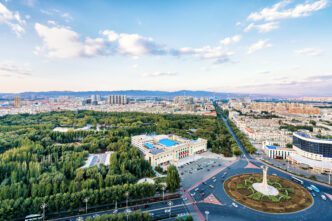In the wake of a devastating earthquake in Port Vila, Vanuatu, rescue teams are working tirelessly to locate survivors amidst destroyed infrastructure and a critical water shortage.
On December 17, 2024, a powerful earthquake with a magnitude of 7.3 struck near Vanuatu’s capital. The quake caused significant destruction, demolishing reservoirs and leaving the region without water. Official reports have confirmed 14 fatalities, although only nine have been verified by the main hospital. The situation remains dire as more individuals are believed to be trapped under the rubble, and 200 injuries have been recorded.
The earthquake’s impact extended to telecommunications, which suffered an almost complete breakdown. Some service providers are beginning to restore phone connections, albeit patchily, while internet services remain down due to damage to the submarine cable. This disruption has made it difficult for residents to confirm the safety of their loved ones.
Among the deceased were two Chinese nationals, as reported by China’s state-run Xinhua news agency. Frantic rescue efforts have continued, focusing on areas where cries for help were heard. A few survivors have been rescued from building debris in downtown Port Vila, yet many remain trapped or have been found dead.
Essential services are severely strained. Vanuatu’s main medical facility, Vila Central Hospital, suffered significant damage, forcing patients to be relocated to a military camp. The absence of water is the most pressing concern. Two primary reservoirs were decimated, leading residents like Milroy Cainton to form long queues to purchase limited supplies of bottled water from stores. The worry over access to clean water surpasses that of electricity.
UNICEF observers have noted an increase in diarrhea among children as evidence of contaminated water consumption. Residents in regained water access areas have been advised to boil water before use. Additionally, significant urban infrastructure has suffered; at least ten downtown buildings were heavily damaged, trapping an indeterminate number of individuals inside.
The disaster reached diplomatic spaces too, damaging a building housing several embassies, including those of the US, UK, France, and New Zealand. Despite the building’s severe condition, the US State Department reports its embassy staff are unharmed, though the building is no longer functional.
Humanitarian and rescue operations face logistical challenges due to likely damages to Port Vila’s seaport and airport, crucial points for aid and economic activities, particularly agricultural exports and tourism. Though the airport is closed to commercial flights for 72 hours, the runway remains open for humanitarian aid facilitated by French engineers. Military relief from Australia and New Zealand is en route, bringing search and rescue teams and supplies to the hard-hit areas.
Port Vila and adjacent villages experienced not only destruction but landslides, complicating rescue operations. Vanuatu’s location along a subduction zone often subjects it to earthquakes, yet buildings are typically designed for such stress. However, the magnitude of this disaster has tested their resilience.
As Vanuatu faces the aftermath of a devastating earthquake, the combined challenges of infrastructure damage and a lack of essential resources underscore the urgency of ongoing rescue and recovery efforts.








